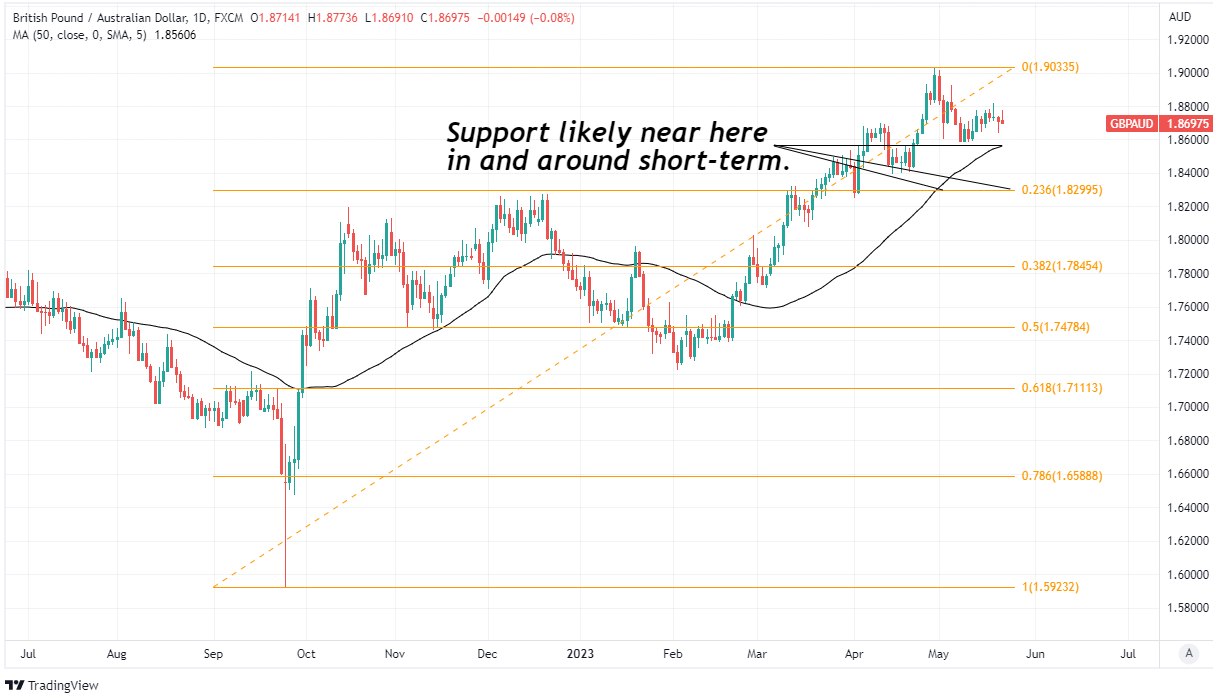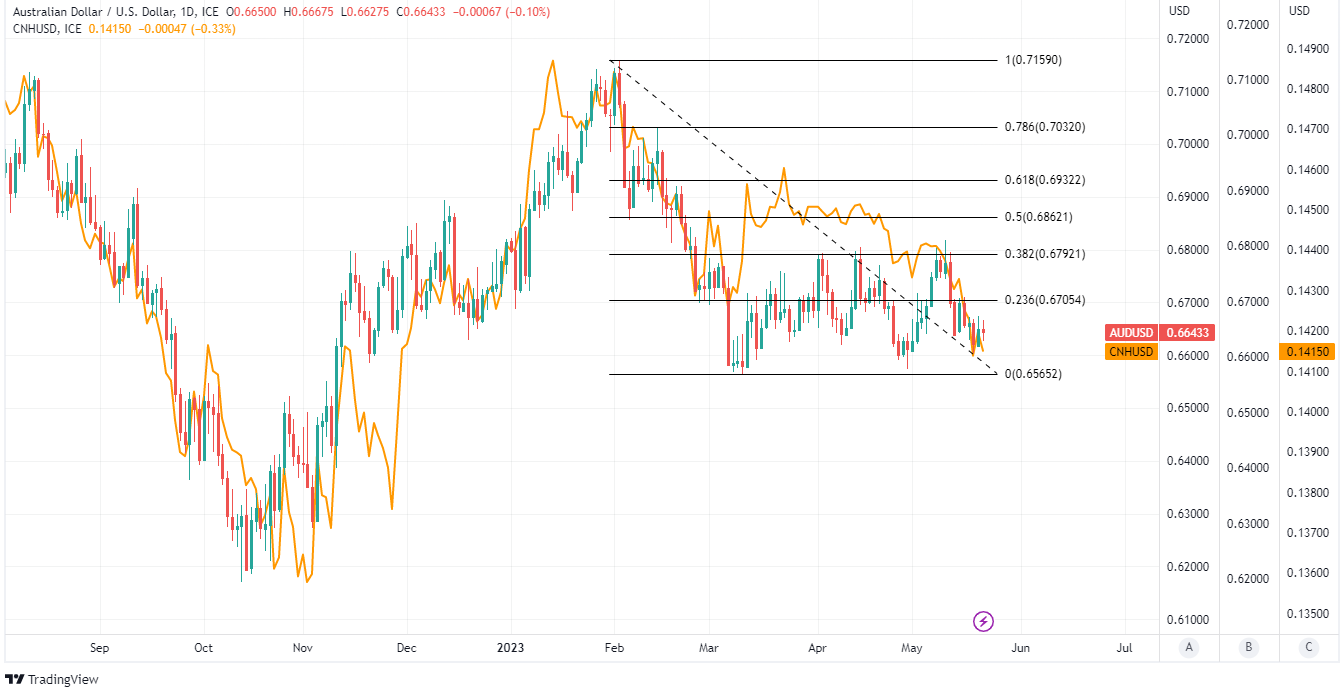GBP/AUD Week Ahead Forecast: Risk of Volatility Emerges
"On A$ crosses, AUD/GBP will be sensitive to UK April CPI" - Westpac.

Image © Adobe Images
The Pound to Australian Dollar exchange rate entered the new week around the middle of a narrow May month range but could be more volatile in the days ahead while on a multi-week basis price action could potentially take Sterling anywhere within a much wider 1.82 to 1.95 range.
Australia's Dollar was a middling performer during European trade Monday and early in what is a quiet week for the local economic calendar while Sterling slipped almost to the bottom of the major currency bucket to open what is almost sure to be a formative period for the UK economic outlook.
"AUD/USD kept to tight ranges last week even as market pricing for another RBA hike increased. In the week ahead, US debt negotiations will be watched each day, while on crosses, AUD/NZD is under pressure ahead of the RBNZ decision on Wednesday," says Sean Callow, a senior FX strategist at Westpac.
"On A$ crosses, AUD/GBP will be sensitive to UK April CPI, where base effects are expected to help inflation finally roll over from above 10% to nearer 8%yr. But AUD/NZD surely has the most at stake as the RBNZ delivers its policy decision on Wednesday," Callow adds in a Monday market commentary.
Monday's losses pulled the Pound to Australian Dollar rate back toward its May lows near the round number of 1.86, though it has remained close to some of its highest levels since the onset of the coronavirus crisis in recent trade, and could be volatile on either side of this level over the coming weeks.
 Above: Pound to Australian Dollar rate shown at daily intervals with selected moving average and Fibonacci retracements of September 2022 uptrend indicating possible areas of technical support for Sterling. Click image for closer inspection.
Above: Pound to Australian Dollar rate shown at daily intervals with selected moving average and Fibonacci retracements of September 2022 uptrend indicating possible areas of technical support for Sterling. Click image for closer inspection.
While the Pound was an underperformer on Monday it remained near the top of the G10 board for the year-to-date with GBP/AUD having seen the third largest gain following an Australian Dollar underperformance that appears to have roots as much overseas as it does at home.
Most recently, modest employment losses and moderating wage growth have combined with a possible end to the Reserve Bank of Australia (RBA) interest rate cycle to keep the antipodean Dollar hamstrung near the bottom of the major currency league table for the year.
But concerns about the outlook for the Chinese economy and currency are also a weight on the Australian Dollar and a source of volatility risk.
"Our trader Irene notes that last Friday's PBoC statement triggered spot profit-taking and the low was at 7.0121 in NY time. But after Asia opened, strong buying interest from interbanks pushed USDCNH trade back to 7.0350," says Naveen Nair, a global markets analyst at Citi.
"It shows the market is still having buying interest on every dip," Nair writes in a Monday market commentary.
 Above: AUD/USD at daily intervals with Fibonacci retracements of February downtrend indicating possible areas of technical resistance, and alongside Renminbi-to-U.S.-Dollar rate.
Above: AUD/USD at daily intervals with Fibonacci retracements of February downtrend indicating possible areas of technical resistance, and alongside Renminbi-to-U.S.-Dollar rate.
Australia's Dollar is the fifth largest component of the China Foreign Exchange Trade System Index against which the Renminbi is managed while the antipodean country has a significant import-export relationship with the world's second-largest economy.
This explains a good part of the correlation between AUD/USD and the Renminbi-Dollar rate, which is in turn a good part of why GBP/AUD could be volatile within something like a 1.82 to 1.94 range as the clarity about the condition of the Chinese economy makes its way to market.
"USD/CNH had a nice run higher before the Friday reversal and there were comments from PBoC officials that spooked the market as well. Some went so far as to call it verbal intervention but that sounds way too extreme for me," says Brad Bechtel, global head of FX at Jefferies.
"The USD/CNH will continue to climb and is unlikely to stop ahead of 7.2000 in the medium term, maybe even higher," Bechtel adds in Monday remarks.
If the recent correlations are anything to go by then, in a scenario where USD/CNH rises to 7.20, AUD/USD would likely fall something like 0.64, which would be almost sure to see GBP/AUD trading up as far as 1.9450.
 Above: Pound to Australian Dollar rate shown at weekly intervals with selected moving average and Fibonacci retracements of 2020 downtrend indicating possible areas of technical support for Sterling. Click image for closer inspection.
Above: Pound to Australian Dollar rate shown at weekly intervals with selected moving average and Fibonacci retracements of 2020 downtrend indicating possible areas of technical support for Sterling. Click image for closer inspection.
But such a rally in managed-floating USD/CNH might be a warning sign about the outlook for the Chinese economy, if not an SOS signal of distress.
In turn, it would also be a troublesome omen for trade partner economies and currencies in the short-term, but one that might be liable for reversal if and when there is a move in Beijing to provide stimulus to the economy.
Such stimulus would normally benefit the antipodean Dollar, given Australia's economy is a large exporter of raw materials and other resources.
"USD/CNH and AUD/CNH can be volatile because of growing cross-currents," says Joseph Capurso, head of international economics at Commonwealth Bank of Australia, writing in a Monday research briefing.
"USD/CNH has lifted by more than 5% since mid-January because of wider US-China interest rate differentials and weaker Chinese economic prospects. Comments on Friday evening suggest the Chinese authorities are concerned about the pace of depreciation," he adds.
Above: Quantitative model estimates of ranges for selected pairs. Source Pound Sterling Live.

